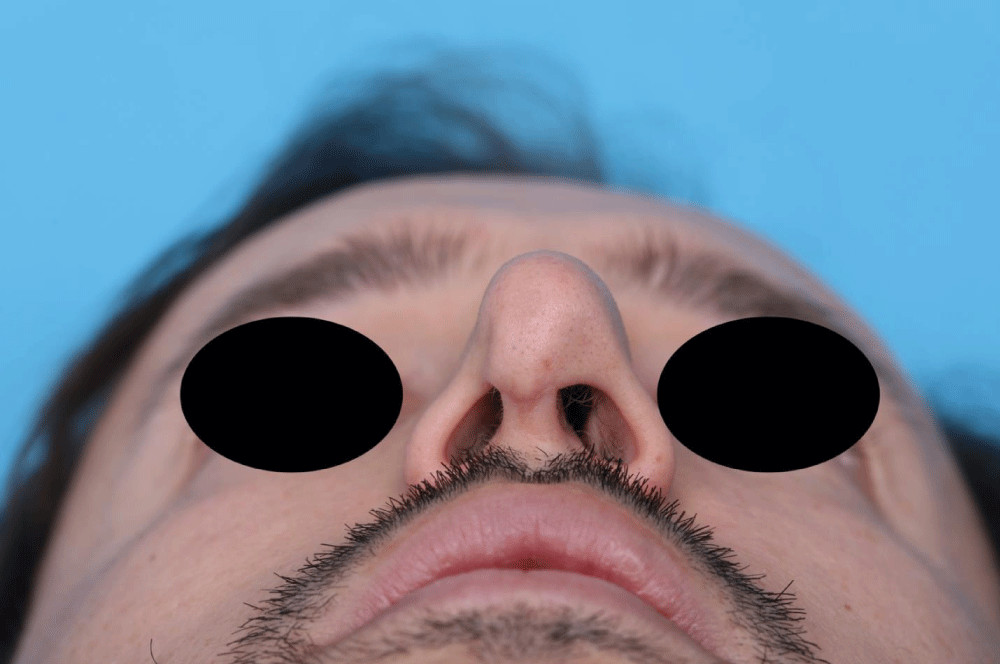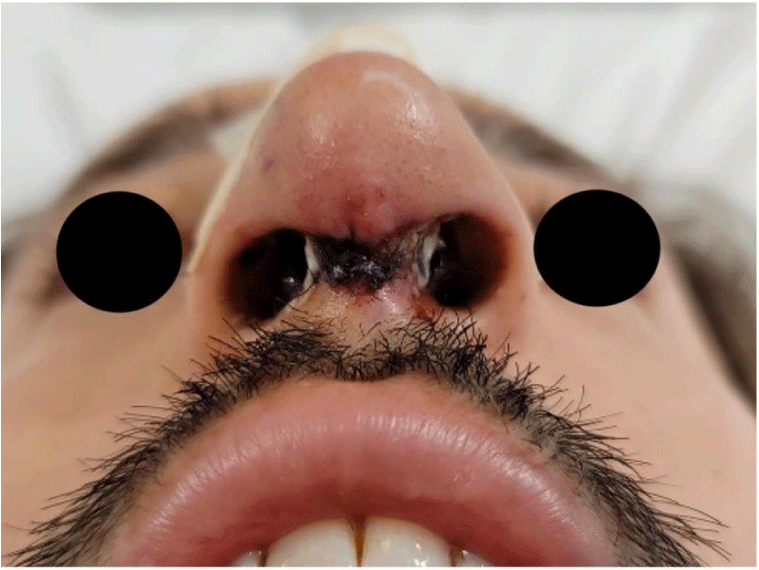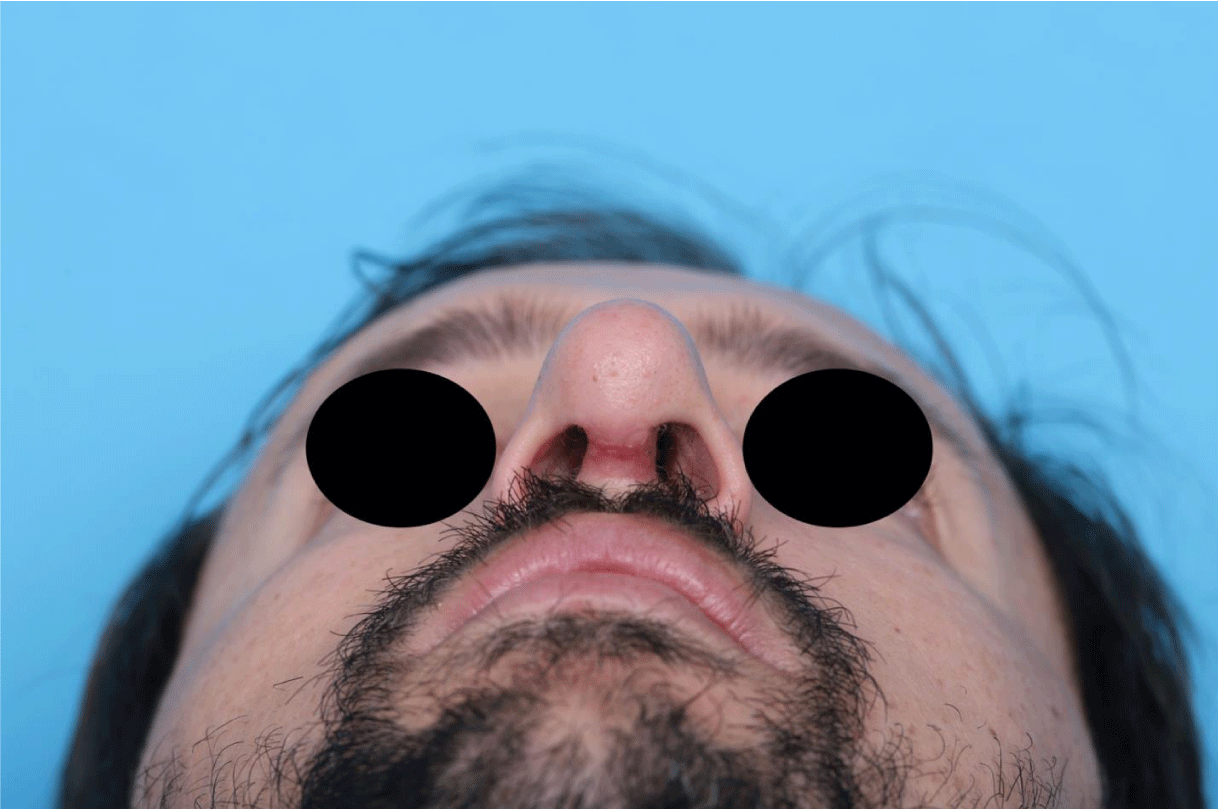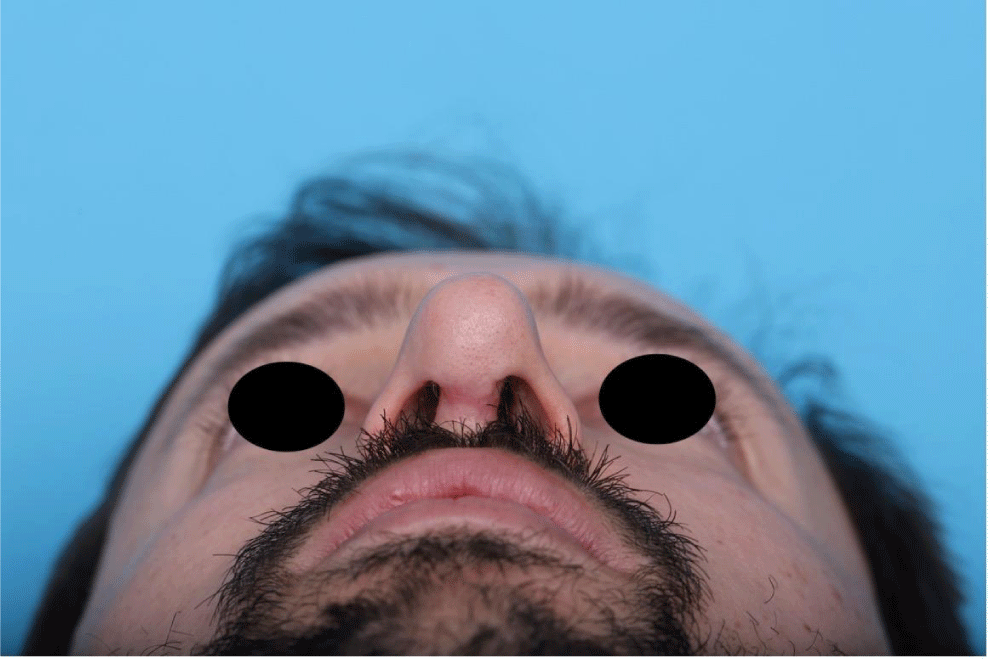Global Journal of Medical and Clinical Clinical Image
Early management of columellar skin necrosis post-revision septorhinoplasty
Ayman Y Jaber1, Osama A Jbarah1 and Leen R Shahin2*
2Hacettepe University Faculty of Medicine, Ankara, Turkey
Cite this as
Jaber AY, Jbarah OA, Shahin LR (2023) “Early management of columellar skin necrosis post-revision septorhinoplasty”. Glob J Medical Clin Case Rep 10(4): 031-034. DOI: 10.17352/2455-5282.000175Copyright License
© 2023 Jaber AY, et al. This is an open-access article distributed under the terms of the Creative Commons Attribution License, which permits unrestricted use, distribution, and reproduction in any medium, provided the original author and source are credited.Background: Columellar skin necrosis is a rare complication of Septorhinoplasty procedures. However, it is more frequent in patients who undergo multiple revision procedures and have poor skin quality. Therefore, some patients require wound care immediately post-operation. Dressing of the columellar region is difficult due to the location and anatomical configuration.
Case presentation: In this paper, we present a case of partial necrosis of the columellar skin following an open Septorhinoplasty procedure which was noted on the first post-operative day. Improving circulation to the affected area was the key target of the treatment approach.
Conclusion: A topical hemoglobin-based oxygenating spray (Granulox, SastoMed GmbH, Georgsmarienhütte, Germany) was applied immediately on the columellar skin wound as it is a simple and easy dressing material and can lead to healing without obvious scarring.
Key points
Question: Would an early, minimally invasive intervention with a hemoglobin-based oxygenating spray in a patient who was diagnosed with partial columellar skin necrosis 24 hours post revision Septorhinoplasty - without the need for surgical management provide a satisfactory outcome?
Finding and meaning: The treatment yielded a good aesthetic outcome in a short duration with no significant side effects and demonstrated the ease of treating a difficult complication without the need for more surgeries.
Introduction
The columella affects the projection of the nasal tip, defines the nasolabial angle, and influences the connection between the nasal base and alar rims. Isolated destruction of the columella can be caused by rhinoplasty, trauma, nCPAP, infection, or malignancy [1]. The relative scarcity of adjacent tissue available for reconstruction along with the distinctive contour, discrete border, and scant blood supply to the columella makes this nasal subunit one of the most difficult to reconstruct [2]. Columellar skin necrosis can be divided into 3 categories: Type A demonstrates mild notching of the columella; Type B has an absent columella without notable nasal tip depression; and Type C has an absent columella with nasal tip depression, with or without external nasal valve obstruction [3]. It can be treated medically using anti-infective, anti-inflammatory, and regenerative agents, or surgically by using a nasolabial flap, forehead flap, nasofacial flap, or subnasal flaps for columellar reconstruction [4].
Blood derivatives can help treat necrosis through the release of growth factors, cytokines, and extracellular matrix modulators that sequentially promote the revascularization of damaged tissue through the induction of migration, proliferation, differentiation, and stabilization of endothelial cells in new blood vessels. They also play a role in the restoration of damaged connective tissue through migration, proliferation, and activation of fibroblasts and the proliferation and differentiation of mesenchymal stem cells into tissue-specific cell types [5,6].
Oxygen plays a vital role in wound healing. Evidence demonstrates that poorly oxygenated wounds almost never heal, while oxygenated wounds do. 97% of non-healing wounds were found to have low oxygen levels. The need for oxygen is particularly high in all phases of wound healing because of increased metabolic activity. The lack of oxygen leads to delayed healing, or in some cases even blocks any progression in healing, even in the absence of other wound healing inhibitory factors [7].
The active substance, hemoglobin, supplies the base of the wound externally with oxygen which supports wound healing [8-10].
Hyperbaric oxygen therapy is considered as one of the main recognized options to treat columellar skin necrosis keeping in mind the cost of using this option and the time and compliance needed to achieve successful results. Hyperbaric oxygen is a form of medical treatment wherein a patient breathes 100% oxygen in a pressurized chamber. This significant increase in the amount of oxygen being received pushes the oxygen into the plasma, lymphatics, and into the distal tissues improving the body’s capability to angiogenesis - the formation of new blood vessels - which in turn increases blood flow and healing factors to hypoxic areas [11]. In this case report, we aim to provide a new modality of treatment for columellar skin necrosis.
Case report
A 33-year-old male patient with a history of 3 prior nasal surgeries visited our department complaining of nasal blockage and external nasal deformity. Upon physical examination, a collapsed nasal valve and right-sided nasal septal deviation were noted. As well as a deformed and deviated nasal tip and columella. The scar of the old rhinoplasty was noted to be improperly placed as it is located exactly at the level of the soft tissue triangle bilaterally (Figure 1). The patient was counseled about the need for revision rhinoplasty with total nasal reconstruction using rib cartilage. The patient was also counselled about the risk of tissue necrosis which is likely to happen after multiple revision rhinoplasties keeping in mind the poor skin quality of the nasal envelope and the presence of tissue fibrosis. A revision open Septorhinoplasty and total nasal reconstruction using rib cartilage harvested from the patient himself was performed, and multiple layers of reconstruction were applied to support the columellar skin and to improve the blood supply using costal perichondrium, fat, and costal cartilage [12]. On day 1 post-operation, a change in the color of the columellar skin to black was noticed between the old columellar scar and the new columellar incision - the area of the poorest blood supply. The initial diagnosis was columellar skin necrosis (Figure 2). Urgent consultation with a wound care specialist was requested. After evaluating the patient’s condition, the initial approach was to contain the ischemia to protect the underlying tissues. One of the main factors that reflect ischemia in this part of the body is the amount of oxygen reaching the tissue, the evaporation rate from the exposed tissue, and the presence of bacteria. Thus, the plan was to maximize oxygen delivery to the tissue, decrease the evaporation rate, prevent infection, and enhance the healing of the underlying tissues. Therefore, application of a daily wound dressing routine was applied as follows:
- Irrigation of the area with an oxidized solution (Fluocinonide) is used as an antiseptic solution without any rubbing.
- Application of topical hemoglobin-based oxygenating spray to maximize the level of oxygen in and around the wound media.
- Application of a small amount of hydrogel with Sodium alginate as an autolytic debriding agent that also provides hydration, thus decreasing the chance of maceration.
- Cover the columellar skin with a non-adherent silicon contact layer to avoid sticking to the gauze that is to be placed over it. The patient was discharged and continued treatment with a specialized nurse once daily at home for 3 weeks.
Follow-up pictures were taken daily to closely monitor the condition of the columellar skin.
After 3 weeks of daily dressing, complete closure of the wound and a satisfactory aesthetic outcome were achieved with minimal evidence of skin loss or depression (Figures 3,4).
Discussion
Septorhinoplasty is one of the most common cosmetic procedures performed by ear nose and throat surgeons worldwide. It is among the top 5 common aesthetic procedures in the United States. The complication rate in rhinoplasty is 8% - 15%, and a majority of these complications are not life-threatening [13]. Cutaneous complications following a rhinoplasty procedure are usually minor and transient, but skin necrosis is one of the rarest and the most serious complications that cause both patient’s and doctors major concern. Although it is usually treated surgically using flaps, in this case report we highlight the possibility of implementing medical treatment instead. There are limited reports in the literature discussing the treatment of post-surgical columellar skin necrosis. Even those are limited to surgical approaches that include harvesting of flaps or medical treatments with less-than-satisfactory cosmetic outcomes – an undeniably important point to consider in the field of plastic surgery.
The patient was followed daily during the duration of the treatment and after the end of the treatment in months 1,3,6 and 9. Improvements in skin condition and thus, the general appearance of the nose, particularly the columellar break were quite rapid during the treatment and in the early stages after the treatment – on month 1. Since no flaps were harvested, there was no concern over harvest action and implantation-related issues such as donor site morbidity, flap necrosis, excessive scarring, or recipient site hematoma. The treatment modality was non-surgical, convenient for both surgeon and patient and easy to apply. Furthermore, the cosmetic outcomes obtained were more than satisfactory, as were the clinical outcomes, particularly due to the complete elimination of long-term complications associated with flap procedures including but not limited to, sensory neuropathies, hypopigmentation of scars and contractures [10]. However, there was a risk albeit, significantly reduced, of the treatment failing and having no choice but to turn to flap transfers probably for a larger area, but the same can be said for flap surgery as well.
Hyperbaric oxygen therapy is also an accepted treatment modality and essentially, functions on the same concept: increased oxygen promotes wound healing. However, exposing the entire body to barotrauma has systemic complications, such as myopic damage, cataract formation, tympanic membrane rupture, dental air pockets, sinus barotrauma, and oxygen toxicity, noting that hyperbaric oxygen therapy is contraindicated in patients with cardiac implants and those with breast prostheses [14,15]. Meanwhile, an external hemoglobin spray’s contraindications are pregnancy and simultaneous use with other topical agents and as stated in the ‘instructions for use manual’, has no reported side effects.
Conclusion
In this paper, medical treatment using a hemoglobin-based oxygenating spray was preferred as an initial treatment to avoid subjecting the patient to yet another operation and to decrease the donor site morbidity that could potentially be caused by flap harvesting. The active substance, hemoglobin, supplies the base of the wound externally with oxygen which supports wound healing . Oxygenating the wound by means of diffusion using a hemoglobin spray is a much simpler and more tolerable technique compared to other treatment options, including hyperbaric oxygen therapy. Medical treatment could be considered a safe and cost-effective method of treatment of partial and early-diagnosed columellar skin necrosis with no decrease in functional and cosmetic outcomes. Medical treatment does not require a waiting period of 6-12 months to surgically re-open the nose and can be carried out immediately once columellar skin necrosis is suspected. It eliminates the need for hospitalization as the patient can continue treatment at home.
Ethical considerations
This article was written with the full consent and understanding of the patient that it will be submitted for publication. The treatment modality used was not selected for the purpose of writing a case report or for experimental purposes, but rather it was selected because it much better suited the patients’ needs and desires. The patient understands that he may withdraw consent at any stage, and it would not affect his treatment.
- Chang CS, Swanson JW, Wilson A, Low DW, Bartlett SP. Columellar Reconstruction following Nasal Continuous Positive Airway Pressure Injury. Plast Reconstr Surg. 2018 Jan;141(1):99e-102e. doi: 10.1097/PRS.0000000000003978. PMID: 28938361.
- Kang IG, Jung JH, Kim ST, Kim YJ. Reconstruction of a columellar defect with a nasolabial island flap. Clin Exp Otorhinolaryngol. 2014 Jun;7(2):142-4. doi: 10.3342/ceo.2014.7.2.142. Epub 2014 May 21. PMID: 24917913; PMCID: PMC4050088.
- Chao JW, Raveendran JA, Sauerhammer TM, Rogers GF, Oh AK, Boyajian M. Columellar Reconstruction After Nasal Continuous Positive Airway Pressure Associated Necrosis. J Craniofac Surg. 2017 Jun;28(4):928-930. doi: 10.1097/SCS.0000000000003296. PMID: 28005655.
- Sherris DA, Fuerstenberg J, Danaher D, IIilgee PA. Reconstruction of the Nasal Columella. 2001. https://www.drsherris.com/articles-and-research/reconstruction-of-the-nasal-columella
- Reinke JM, Sorg H. Wound repair and regeneration. Eur Surg Res. 2012;49(1):35-43. doi: 10.1159/000339613. Epub 2012 Jul 11. PMID: 22797712.
- Guo S, Dipietro LA. Factors affecting wound healing. J Dent Res. 2010 Mar;89(3):219-29. doi: 10.1177/0022034509359125. Epub 2010 Feb 5. PMID: 20139336; PMCID: PMC2903966.
- Yip WL. Influence of oxygen on wound healing. International Wound Journal. 2015; 12(6): 620-624.
- Mölnlycke, Topical haemoglobin spray for chronic wound therapy. 2016; 3: 7.
- Loh C, Tan QY, Eng DLK, Walsh SR, Chong TT, Tang TY. Granulox-The Use of Topical Hemoglobin to Aid Wound Healing: A Literature Review and Case Series From Singapore. Int J Low Extrem Wounds. 2021 Jun;20(2):88-97. doi: 10.1177/1534734620910318. Epub 2020 Apr 29. PMID: 32349571.
- Hom DB, Ostrander BT. Reducing Risks for Local Skin Flap Failure. Facial Plast Surg Clin North Am. 2023 May;31(2):275-287. doi: 10.1016/j.fsc.2023.01.006. PMID: 37001930.
- Jones MW, Cooper JS. Hyperbaric Therapy for Wound Healing, in StatPearls. 2022, StatPearls Publishing Copyright © 2022, StatPearls Publishing LLC.: Treasure Island (FL).
- Gvaramia D, Kern J, Jakob Y, Zenobi-Wong M, Rotter N. Regenerative Potential of Perichondrium: A Tissue Engineering Perspective. Tissue Eng Part B Rev. 2022 Jun;28(3):531-541. doi: 10.1089/ten.TEB.2021.0054. Epub 2021 Jun 30. PMID: 33966486.
- Mrad MA, Almarghoub MA. Skin Necrosis following Rhinoplasty. Plast Reconstr Surg Glob Open. 2019 Feb 8;7(2):e2077. doi: 10.1097/GOX.0000000000002077. PMID: 30881829; PMCID: PMC6416127.
- Sadri RA, Cooper JS. Hyperbaric Complications. [Updated 2022 Sep 19]. In: StatPearls [Internet]. Treasure Island (FL): StatPearls Publishing; 2023 Jan-. Available from: https://www.ncbi.nlm.nih.gov/books/NBK459191/
- Elg F, Hunt S. Hemoglobin spray as adjunct therapy in complex wounds: Meta-analysis versus standard care alone in pooled data by wound type across three retrospective cohort controlled evaluations. SAGE Open Med. 2018 Jun 27;6:2050312118784313. doi: 10.1177/2050312118784313. PMID: 30013783; PMCID: PMC6041853.

Article Alerts
Subscribe to our articles alerts and stay tuned.
 This work is licensed under a Creative Commons Attribution 4.0 International License.
This work is licensed under a Creative Commons Attribution 4.0 International License.





 Save to Mendeley
Save to Mendeley
